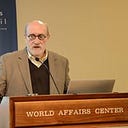The true story of the English sailor of the novel and TV series “Shogun”

The word “shogun” entered the English language in 1975 with the publication of James Clavell’s blockbuster bestselling novel, Shogun. And it gained broader attention earlier this year with the release of the 10-episode FX television series of the same name. Now, a professor of history living in Kyoto has told the true story of the real-life English pilot, William Adams, on whom Clavell based his fictional English pilot, John Blackthorne. Frederik Cryns bases his book, In the Service of the Shogun, on primary historical sources — and it’s as exciting as the fictional retelling. It’s the true story of Shogun. Also, as Cryns notes, “Clavell only used six months of Adams’s life as a model for his novel, but the other 55 years are worth studying too.” As Cryns did, using not just English but also surviving Japanese, Portuguese, and Spanish documents to piece Adams’s story together.
THE REAL-LIFE JOHN BLACKTHORNE
William Adams (1564–1620) drifted ashore in Japan in 1600, becoming the first Englishman to reach the fabled country. He had apprenticed as a shipbuilder as a boy of twelve and was the master of a supply ship for the Royal Navy during the invasion of the Spanish Armada. Soon thereafter, he trained as a pilot on merchant ships, shipping out in 1598 as a pilot major on one of five Dutch ships bound for the East Indies (present-day Indonesia).
The long voyage was more than commonly troubled, and by the time Adams made it through the Straits of Magellan, his was the only one of the five ships still afloat in the Pacific. But he and his surviving crew were blown far off course to the north, and when they reached Japan the crew was sick and dying. “There were 24 men left on board, only five of whom, including Adams, were able to walk.”
IN THE SERVICE OF THE SHOGUN: THE REAL STORY OF WILLIAM ADAMS BY FREDERIK CRYNS (2024) 256 PAGES ★★★★☆

THE VOYAGE OF WILLIAM ADAMS TO THE PACIFIC
Astronauts face constant danger when they leave the surface of the Earth. But few die. Not so with the explorers of the late sixteenth and seventeenth centuries. Not just from scurvy and the powerful storms that posed a constant threat of shipwreck but also death in battle. Because low-intensity war was unending beginning during the reign of Elizabeth I.
“Before her reign,” Cryns observes, “wars between European countries had mainly been the result of rivalries between monarchs. Once one side had won, the war was over, and the aftermath was settled with the transfer of land and ransoms. But religious wars, which became more frequent during the queen’s reign, could only end with the complete destruction of the other side’s faith.” And there was no respite in the conflict between the Catholic nations of Spain and Portugal and the Protestant lands of England and the Netherlands.
English privateers preyed on the merchant ships of the Spanish and Portuguese. And the powerful vessels of the Spanish and Portuguese represented a constant threat to Protestant merchants. Because of run-ins with enemies as well as endemic illness and lack of food, “only about three hundred of the five hundred men who had left Rotterdam were still alive” when the five Dutch ships arrived on the West Coast of South America after passing through the Straits of Magellan. And soon Adams’s ship was alone in the Pacific.
JAPAN BEGINS TO AWAKE
Tokugawa Ieyasu (1543–1616) was the founder of the last shogunate in Japan — the Tokugawa, or Edo, shogunate (1603–1867) — which ended only with the Meiji Restoration (1868–1912) that ushered Japan into the modern world. William Adams, as a close adviser of Ieyasu, helped the older man understand the global context from which Japan had been largely cut off.
It’s true, of course, that both Portuguese Jesuits and merchants as well as Dutch merchants had been visiting the islands for fifty years. But neither found it in their interest to educate the Japanese about the wider world. Adams, who was literate unlike most of his peers, was familiar with many of the books in common circulation in his time. He was more forthcoming with Ieyasu and thus played a pivotal role in helping the warlord forge a foreign policy that laid the foundation for the shogunate to last for three centuries. He also served as an interpreter for Ieyasu with the British and Dutch merchants who arrived in the years following his own arrival in Japan. And he was instrumental in securing commercial favors for them despite fierce opposition by the Jesuits.
But Adams’s relationship with Ieyasu went far deeper. He “acted as his tutor. He taught him the rudiments of geometry, mathematics and other subjects. Ieyasu, who had always shown a keen interest in learning, was delighted and grew closer to him.” And Ieyasu rewarded him with a title and lands comparable to that of an earl in his native land. But the shogun passed from the scene in 1616, and Adams survived him by only four years.
ABOUT THE AUTHOR

Frederik Cryns is a professor of Japanese history at the International Research Center for Japanese Studies, in Kyoto, Japan. He has written several bestselling books in Japanese on the early interaction of the Western world with Japan. Cryns appears frequently on Japanese television history programs and served as a consultant on the FX television series, Shōgun.
FOR RELATED READING
You might care to check out:
- 10 great biographies
- 20 top nonfiction books about history
- Top 10 nonfiction books about politics
- 25 most enlightening historical novels
And you can always find my most popular reviews, and the most recent ones, on the Home Page of Mal Warwick on Books.
